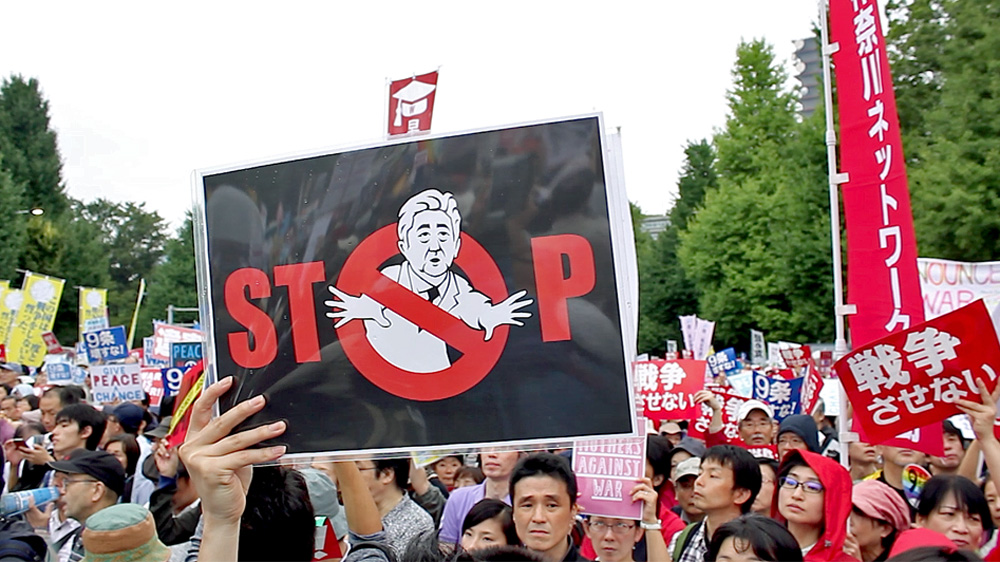Weakness of opposition is Prime Minister Abe’s only strength
Carl Simmons, Kokusai Rentai (CWI in Japan)
Shinzo Abe recently became the longest serving Japanese prime minister in nearly four decades. His Liberal Democratic Party (LDP) government has regained its lead in opinion polls, despite the huge demonstrations of last summer against new security laws, which a majority of the population clearly opposed.
This temporary stabilisation has been possible largely because of the weakness of the opposition and the fact that the failure of “Abenomics” has not yet become apparent to the mass of the population. However, this is likely to prove only a brief respite for the government. Behind the facade of political and social stability, Japanese capitalism faces an enormous crisis – even before the recent volatility in global equity markets.
Japan’s average real GDP (total output) growth since 1990 has averaged under 1%. What started as “the lost decade” has now become “the lost 20 years.” The nature of this decline is indicated by a brief report carried by NHK, the national broadcaster, just before the New Year holiday. It indicated that Japan had fallen to 20th place in the OECD rankings of GDP per capita. This is its lowest ranking since 1970.
In addition to this slow economic decline, Japan faces a rapid decline in its population. A government sponsored report has warned that by 2060 the number of Japanese will have fallen from 127 million to about 87 million, of whom almost 40% will be 65 or older.
The rise of China
The sense of crisis and alarm at national decline has been exacerbated by the dramatic rise of China as a major world economic and military power, and rival. Hardly a week passes without some factoid surfacing in the Japanese press to illustrate this relative decline. For example, for the first time, Chinese universities outnumbered Japanese in rankings of the top Asian universities, and publications by Chinese in science journals now outnumber Japanese. Alongside this are reports of the Chinese military build-up, especially in naval power.
It is this sense of crisis that has fuelled the rise of Abe with his nationalist rhetoric. It can be seen in the changing nature of the LDP. In the past this party was dominated by personal cliques supporting individual Diet members (MPs) who doled out funds for construction projects and took turns in sharing cabinet positions and the position of Prime Minister with policy differences often taking second place. The party today is dominated by the shadowy Nippon Kaigi (Japan Conference) for which Abe acts as an advisor. This rightist group within the LDP is now estimated to have the support of 289 Diet members and a majority of members of Abe’s cabinet.
While Abe is personally committed to the rightists’ reactionary ideology and their programme of constitutional revision, he is also aware that the mood doesn’t presently exist in Japanese society for such a wholesale turning back of the clock and restriction of democratic rights. The passage of the Secrecy Protection Bill, the attempts to silence opposition by bullying the press, and now, the passage of the new security laws have alarmed a segment of society and most significantly has awakened a layer of youth to political activity. Although it has been temporarily defeated, the movement of last summer against the proposed security laws has not been without its effects on society.
Abe’s strategy
In the run-up to July’s general election, Abe will emphasise the opposition’s lack of any alternative to Abenomics. While constitutional revision may not be the main emphasis of his campaign, he will attempt to exploit incidents such as the North Korean nuclear test or further incursions by Chinese ships into waters claimed by Japan to promote the idea of constitutional revision. However, he will tread carefully. He knows that it will not be an easy matter to win a majority in a referendum on constitutional change and that ultimately the success or failure of his government rests with its economic policies.
The failure of Abenomics
The initial effect of the government’s policies of ‘quantitative easing’ (QE) was to boost the profitability of the major corporations. Some 30% of the companies in the first section of the Tokyo Stock Exchange announced record profits for 2014. That was the highest figure since 2006 when 36% did so. Overall profits rose 6.7% among those companies in 2014.
This had boosted the confidence of the business world. Before the New Year plunge the TSE was at its highest level for 16 years, having more than doubled since Abe came to power. The already wealthy gained most. The National Tax Agency reported the number of people whose income is greater than ¥500 million per annum ($4.26m), has risen from 578 in 2010 to 1,515 by 2013.
The gains in profitability have come mainly from a fall in the value of the yen as a result of Abe’s policies. Despite this, Japan is still today running a sizeable trade deficit. While the yen’s fall has boosted exports for the car industry and other major exporters, overall profits have been boosted mainly by the increasing yen values of repatriated profits from Japanese companies abroad. An increase in cash held by major companies will not by itself be enough to maintain the recovery. For that to happen the profits need to be reinvested.
At the end of last year Abe and BOJ head Kuroda were busy exhorting the Keidanren (the main Japanese business organisation) to boost investment. According to reports, when Kuroda informed them that, “Fortune favours the bold,” they seemed unconvinced. In the face of a stagnant domestic market and a slowdown in China, they wanted to know where the sales were going to come from. Even if there is a market for the new goods being produced, why should companies make those investments in Japan? The fall in the yen has hardly made a dent in the trend to move production overseas.
According to the Japan Bank for International Cooperation, Japanese companies made just over 35% of their products abroad in fiscal 2014 up from just 14% in 1989. This is projected to reach nearly 40% by 2018. Much of this investment is destined for Indonesia, Malaysia, the Philippines, Singapore and Thailand.
Alongside calls for increased investment the bank also urged the bosses to increase wages. Employers’ organisations have paid lip service to higher wages, but individual companies would rather let their competitors take the initiative boosting demand for goods than sacrifice their own profits. Ironically Bank of Japan head Kuroda has even criticised the conservative labour unions for not pressing hard enough for pay increases! The failure of Abenomics may yet be blamed on the company unions that were once lauded as a major factor in the success of Japanese capitalism. While the average wage has risen slightly, it hasn’t kept up with the rate of inflation. Even where companies have increased wages, it has commonly been in the form of increased bonuses.
Abe and Kuroda’s original plan was a target of 2% inflation, which they believed would force businesses and consumers to spend or to see existing cash reserves lose their value. However, despite three years of QE and a massive expansion of the money supply, inflation has averaged a measly 0.2% since July, well short of the government’s target. As a result of the expansion measures government debt has risen to the highest in the OECD at 226% of GDP. The government has been able to service the debt because of low interest rates. The danger is that interest rates, likely to rise with inflation could trigger a debt crisis. With the economy narrowly avoiding a second recession in the third quarter of 2015 the present recovery is anything but robust. The true legacy of Abenomics has been a lacklustre and unimpressive recovery with continuing attacks on workers’ living standards.
The end of “lifetime employment”
The third arrow of Abenomics was supposed to be “structural reform,” a euphemism for making it easier for employers to fire workers. The “lifetime employment system,” once seen as a pillar of social stability, has been seriously undermined. Full-time permanent workers made up 85% of the workforce in 1984. This has dropped to just under 60% today. The recent relaxation of restrictions on ‘dispatch work’ (a labour pool system) mean that this trend will continue.
The increase in irregular workers has brought with it a major increase in poverty. In 2013 the average income of contingent workers was only ¥1.68 million compared to ¥4.73m for regular workers. The number of working poor, who earn less than ¥2 million a year, reached a record 11.39 million in 2014 – around one in every six workers. Reports that nearly 15% of children under the age of 17 were living in households earning below the official poverty line of ¥1.22m a year, demonstrate the increasing poverty.
Abe and his advisors understand the weakness of the present recovery. Japan could be plunged into another deflationary spiral at any time. He is hoping that he can make it through to the Upper House elections next year without another downturn. This lies behind talk of bringing Lower House elections forward to this summer and going for a double election. It also explains the supplementary budget with the ¥30,000 handout to low income pensioners and the concessions made to coalition partner Komeito, in exempting food from the consumption tax increase due in April 2017. If the economy deteriorates, it is possible that he could postpone the increase once more.
The weakness of the opposition
The most significant factor Abe can count on is the weakness of the opposition. The main opposition party, the Democratic Party of Japan (DPJ), is a lash-up of LDP renegades and former sections of the Social Democratic Party – predominantly from its right-wing – supported by the largest and most conservative trade union federation, Rengo.
The DPJ in government from 2009 to 2012 carried out even more orthodox neoliberal policies than Abe. It betrayed its supporters by increasing the consumption tax, something which in its election propaganda it had promised not to do. It is not even united on issues such as constitutional revision and includes lawmakers who visit the Yasukuni shrine with its enshrined class ‘A’ war criminals, long associated with Japan’s ultra-rightists. It recently agreed a joint program with the neo-liberal Ishin party that included the call for a reduction of 20% in expenditure on public sector wages. This from a party that has the support of major public sector unions such as the Municipal Workers and the Japan Teachers Union.
To its left, but a shadow of its former self, is the Social Democratic Party, the successor of the Japan Socialist Party, once the mass party of Japanese workers. Only a major force in Okinawa, it will not even have candidates in the majority of constituencies in next summer’s election.
The Japanese Communist Party (JCP) – the only party on the left capable of attracting sizeable electoral support on a national basis – has gained ground in opinion polls and in elections earlier last year. However, while its support is up, its membership is ageing rapidly. JCP is distrusted by many workers and union activists who formerly supported the SDP. And while they may vote for the JCP candidate for lack of an alternative they do not regard it as their party.
The JCP relegates the idea of socialism to the distant future. Its programme states: “A change Japanese society needs at present is a democratic revolution instead of a socialist revolution.” It still doesn’t believe that Japan, a major imperialist power, has achieved national independence from the USA.
Recently the party has undertaken an important shift in tactics. Previously it had been reluctant to cooperate with any group outside of its own ranks, maintaining its own union federation, and citizen groups under party control. It stood candidates in every constituency, regardless of its support. However with the rise of right wing populist forces supporting constitutional revision, such as Hashimoto’s Osaka Ishin no Kai and, nationally, Abe, it has reversed this stance and have not only withdrawn their own candidates, but even, in Osaka at least, supported LDP candidates as the lesser evil.
An opposition alliance?
The call for a broad opposition alliance to stop Abe has gained an echo. The youth organisation, SEALDs (Student Emergency Action for Liberal Democracy) which played an important role in the movement against the Secrecy Act and security laws of last summer, held a press conference with four other citizens’ groups. They appealed to opposition parties to agree a single candidate in single seat constituencies and sign an agreement with the candidate to seek the abolition of the security laws. They have also appealed for other citizens’ groups to join the movement and endorse their call.
While it is a progressive idea that politics cannot be left to the Diet members and bureaucrats and that the youth and ordinary citizens must take action, this strategy will not actually succeed.
A test of this approach was provided by the recent mayoral and gubernatorial (governor) elections in Osaka, the largest city in Western Japan. The opposition parties, including the local chapter of the LDP, lined up together against Ishin no Kai’s candidates.
Ishin’s proposals for reorganisation of the Osaka local government had recently been defeated in a referendum. Despite this their candidates won by a landslide. Instead of focussing on their policies, Ishin was able to use vague right-wing populist phrases about all of the parties ganging up on it to prevent change. It was able to use the fact that their opponents did not agree on policies. It is true that this tactic was easier for Ishin because it is formally an opposition party, however, Abe is already using the same approach as Hashimoto.
While the desire of activists to turn the Upper House election into a single issue poll on Abe’s security bills is understandable, it is unlikely to wash with those sections of society, including the poor, for whom economic questions are of far more pressing concern. This approach would mean supporting candidates who back neoliberal economic policies and cuts in living standards, including a 20% reduction in the public sector wage bill. Even candidates’ agreement to support abolition of the security laws in reality means very little. A candidate could well oppose the laws believing them to be unconstitutional, while supporting constitutional revision.
The way forward
Instead of a call for opposition unity, what is needed is a call for an alliance of citizens’ groups, fighting labour unions and leftist political parties around a programme of struggle. This could offer a clear way forward for all the discontented in society. Such a programme, would call for abolition of the Secrets law and the Security laws, but also opposition to Abe’s plans for constitutional revision, and the presence of US military bases in Okinawa.
It would include opposition to nuclear power and the present energy policy that threatens environmental destruction. It would also advance a programme of economic demands for workers and the poor, demanding a minimum wage of ¥1500 per hour, permanent status for irregular workers and reform of health insurance to ensure 100% coverage.
It would also need to fight for gender equality and against the reactionary attitudes towards women of the LDP and Nihon Kaigi.
Such an alliance, if realised, could lay the basis for a new party of the left, which would pose a real socialist alternative to capitalism, which in the present epoch brings with it restrictions on democratic rights, discrimination, inequality, environmental destruction and war.





